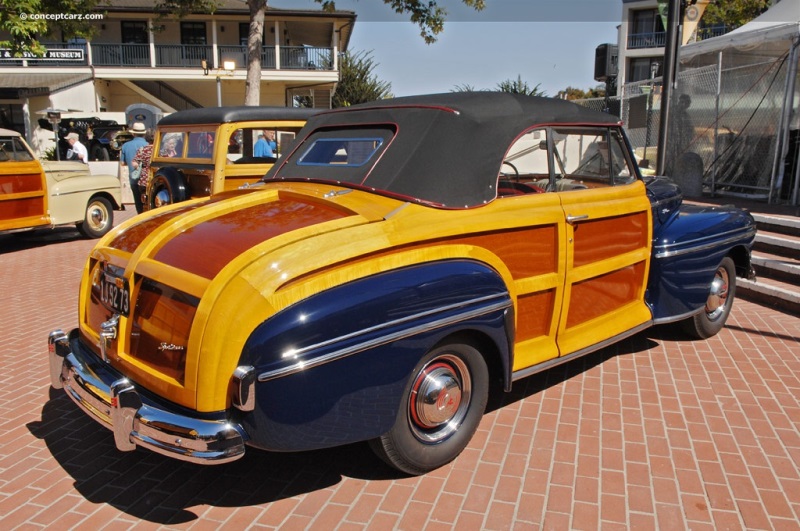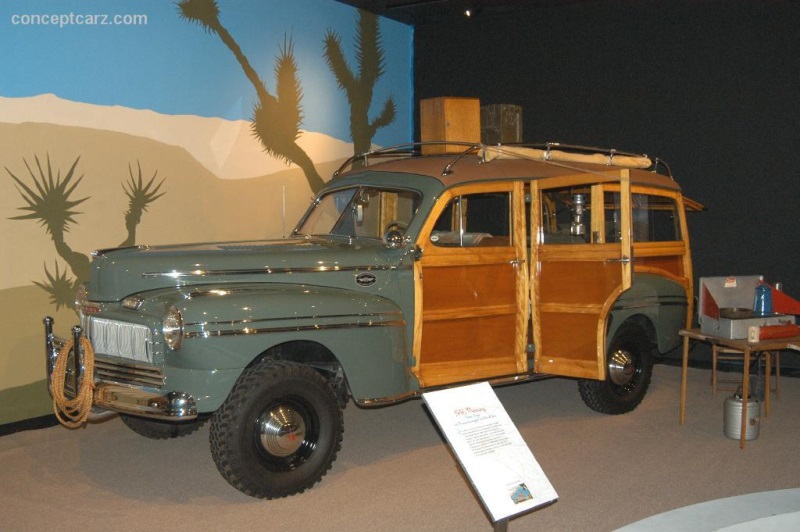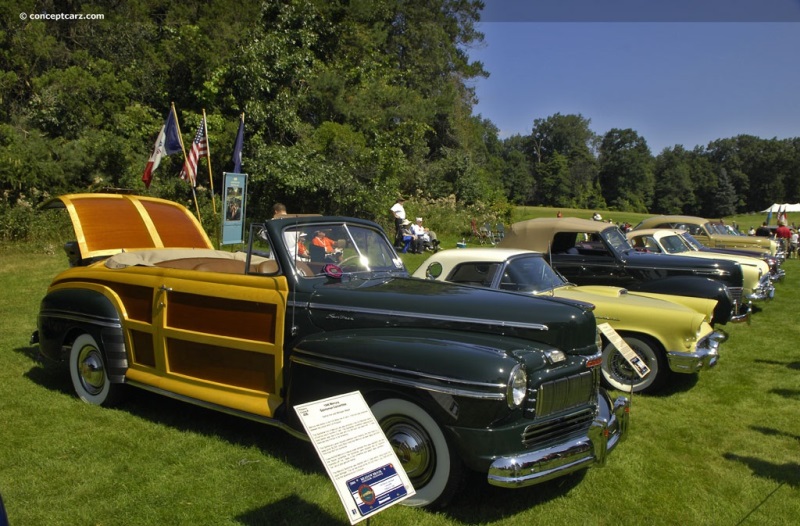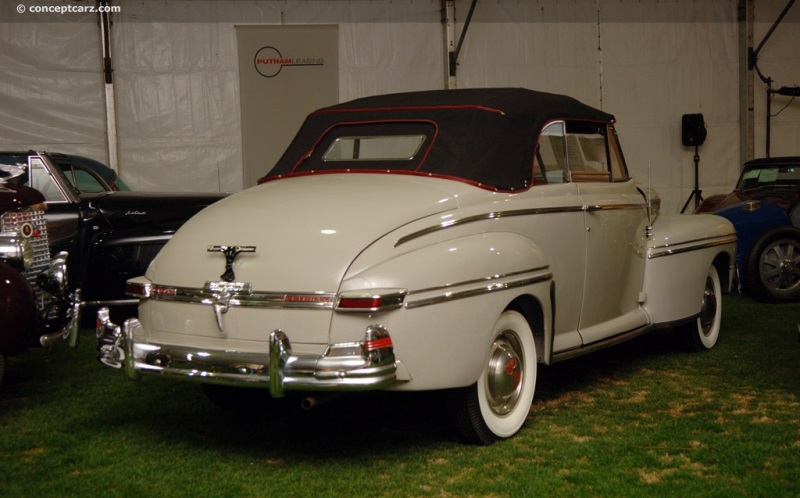1942 was the final year of automobile production prior to the shutdown in support of the war effort. After World War II, civilian automobile production resumed in 1946 with most manufacturers offering mildly updated styling on their pre-war vehicles. New Ford / Mercury / Lincoln designs and models were scheduled for introduction in June of 1948, so all of the company's efforts and resources were focused on its success. The first all-new postwar Mercurys wearing new and modern designs were introduced on April 29th of 1948.
Like most automakers, Ford worked quickly to meet the pent-up demand for new cars while battling labor disputes and materials shortages. The 1946 Mercury wore a new grille with thin vertical bars surrounded by a larger body-colored trim piece. Body styles were extensive, with two-door styles that included a sportsman convertible, sedan, sedan coupe, and a convertible. Four-door body styles included an eight-passenger station wagon and a town sedan. Despite the production problems and shortages, Mercury finished the year in 12th place among American car manufacturers.
The 1946 Mercury was powered by an L-head V-8 engine displacing 239.4 cubic inches and developing 100 horsepower at 3,800 RPM. It was backed by a three-speed manual transmission and the Liquamatic Drive automatic option was no longer available.
Both Ford and Mercury received the Sportmans model for 1946, with the Ford Super Deluxe version costing $1,982 which was roughly $500 more than a standard convertible. The Mercury Sportsman, introduced in April of 1946, sold for $2,209 which was about the same margin over a regular Mercury convertible. This new body style was in response to the Chrysler Corporation's novel barrel-back Town & Country sedan wagon introduced prior to the start of the war. It was produced as a Royal in 1941 and Windsor in 1942. Although they planned on producing five woodie styles for 1946, only a Windsor sedan and New Yorker convertible were put on sale. Nash offered an Ambassador sedan and sold it as the Suburban from 1946 to 1948, and Chevrolet offered a dealer-installed Country Club wood kit for its 1946 through 1948 models.
During the war, Henry Ford II had tasked chief designer E.T. 'Bob' Gregorie to create a body for a Model A chassis that was sitting in a corner of the Ford design studio. Gregorie penned a wood-bodied convertible with a forward-sloped tail, Continental spare, two doors, a khaki top, and a red leather interior. The coupe design was stylish, with a pillar similar to that of the late 1920s Model A closed cars. The design was applied to the Model A chassis and used by the Fords for a summer on Long Island, after which it was given to Gregorie, who kept it and took it to Florida after his retirement.
The postwar Ford product line shared many design cues with the Model A convertible. In the early part of 1945 Gregorie and his lead illustrator, Ross Cousins created drawings for the wood-bodied 1946 convertible. An early production convertible was removed from the production line and built as a prototype at Iron Mountain using wood for the body. To help restrain costs and simplify manufacturing, convertible parts were used wherever possible. The wood framing was larger than the equivalent steel, resulting in the back end being bulkier and the convertible fenders would not work. So the team simply used the taillights and rear fenders from the 1941 sedan delivery. Sportsman seats were upholstered in genuine leather facings in red or tan, with French stitching. Power windows were standard, and the front floor mats had color-keyed carpet inserts.
The first Sportsman was completed in December of 1945 and presented to actress Ella Raines at Christmas. Total Mercury Sportsman Convertible production for 1946 was 205 units. In comparison, a total of 723 of the Ford Sportsman Convertible were built.
by Daniel Vaughan | May 2020
Like most automakers, Ford worked quickly to meet the pent-up demand for new cars while battling labor disputes and materials shortages. The 1946 Mercury wore a new grille with thin vertical bars surrounded by a larger body-colored trim piece. Body styles were extensive, with two-door styles that included a sportsman convertible, sedan, sedan coupe, and a convertible. Four-door body styles included an eight-passenger station wagon and a town sedan. Despite the production problems and shortages, Mercury finished the year in 12th place among American car manufacturers.
The 1946 Mercury was powered by an L-head V-8 engine displacing 239.4 cubic inches and developing 100 horsepower at 3,800 RPM. It was backed by a three-speed manual transmission and the Liquamatic Drive automatic option was no longer available.
Both Ford and Mercury received the Sportmans model for 1946, with the Ford Super Deluxe version costing $1,982 which was roughly $500 more than a standard convertible. The Mercury Sportsman, introduced in April of 1946, sold for $2,209 which was about the same margin over a regular Mercury convertible. This new body style was in response to the Chrysler Corporation's novel barrel-back Town & Country sedan wagon introduced prior to the start of the war. It was produced as a Royal in 1941 and Windsor in 1942. Although they planned on producing five woodie styles for 1946, only a Windsor sedan and New Yorker convertible were put on sale. Nash offered an Ambassador sedan and sold it as the Suburban from 1946 to 1948, and Chevrolet offered a dealer-installed Country Club wood kit for its 1946 through 1948 models.
During the war, Henry Ford II had tasked chief designer E.T. 'Bob' Gregorie to create a body for a Model A chassis that was sitting in a corner of the Ford design studio. Gregorie penned a wood-bodied convertible with a forward-sloped tail, Continental spare, two doors, a khaki top, and a red leather interior. The coupe design was stylish, with a pillar similar to that of the late 1920s Model A closed cars. The design was applied to the Model A chassis and used by the Fords for a summer on Long Island, after which it was given to Gregorie, who kept it and took it to Florida after his retirement.
The postwar Ford product line shared many design cues with the Model A convertible. In the early part of 1945 Gregorie and his lead illustrator, Ross Cousins created drawings for the wood-bodied 1946 convertible. An early production convertible was removed from the production line and built as a prototype at Iron Mountain using wood for the body. To help restrain costs and simplify manufacturing, convertible parts were used wherever possible. The wood framing was larger than the equivalent steel, resulting in the back end being bulkier and the convertible fenders would not work. So the team simply used the taillights and rear fenders from the 1941 sedan delivery. Sportsman seats were upholstered in genuine leather facings in red or tan, with French stitching. Power windows were standard, and the front floor mats had color-keyed carpet inserts.
The first Sportsman was completed in December of 1945 and presented to actress Ella Raines at Christmas. Total Mercury Sportsman Convertible production for 1946 was 205 units. In comparison, a total of 723 of the Ford Sportsman Convertible were built.
by Daniel Vaughan | May 2020
Mercury
Similar Vehicles
Similarly Priced Vehicles
1946 Mercury Series 69M Vehicle Profiles
Recent Vehicle Additions
Performance and Specification Comparison
Price Comparison
Related Automotive News

Welcome Back: Chrysler Voyager Returns Budget-friendly Option to Chrysler Family of Minivans
Chrysler returns Chrysler Voyager to retail lineup with a budget-friendly price point starting under %2440,000 with a U.S. manufacturers suggested retail price (MSRP) of %2439,995 (excluding destination charge)
Chrysler family of minivans ranges from...

The all-new Škoda Superb: More space, more comfort, more efficiency and more safety
Refined flagship ICE model distinguished new look, more advanced aerodynamicsMore space and comfort roomier, clean interior design featuring sustainable materials, intuitive...

Make Lancia Great Again: London Concours Reveals Lancia Legends Display
The London Concours has announced its Lancia Legends display – a celebration of cars from the golden era of Lancia
Line-up includes icons like Henri Toivonens Lancia 037 Rally Evo 2, a one-of-59 B24 Spider and the ultimate Flaminia a Super Sport...

RM Auctions to Present The Merrick Auto Museum Collection at 13th Annual Hershey Sale
OVER 100 BRASS ERA CARS AND SELECTION OF MEMORABILIA OFFERED ENTIRELY WITHOUT RESERVE
RM Auctions set to offer the Merrick Auto Museum Collection at Hershey auction, 10-11 October in Pennsylvania
Offered entirely without reserve, the multi...

Pebble Beach Concours d'Elegance Introduces Its First Sport Customs Class
One-off Sport Customs designed to turn heads while tooling down Main Street USA will roll onto the 18th fairway of Pebble Beach Golf Links for the 2012 Pebble Beach Concours dElegance on August 19.
This year, for the very first time, the Pebble Beach...



















